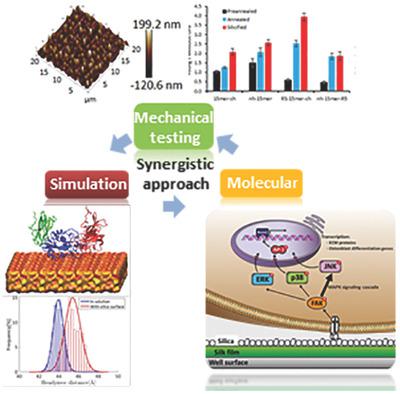当前位置:
X-MOL 学术
›
Adv. Funct. Mater.
›
论文详情
Our official English website, www.x-mol.net, welcomes your feedback! (Note: you will need to create a separate account there.)
Intracellular Pathways Involved in Bone Regeneration Triggered by Recombinant Silk–Silica Chimeras
Advanced Functional Materials ( IF 19.0 ) Pub Date : 2017-09-04 , DOI: 10.1002/adfm.201702570 Zaira Martín-Moldes 1 , Davoud Ebrahimi 2 , Robyn Plowright 3 , Nina Dinjaski 4 , Carole C Perry 3 , Markus J Buehler 2 , David L Kaplan 1
Advanced Functional Materials ( IF 19.0 ) Pub Date : 2017-09-04 , DOI: 10.1002/adfm.201702570 Zaira Martín-Moldes 1 , Davoud Ebrahimi 2 , Robyn Plowright 3 , Nina Dinjaski 4 , Carole C Perry 3 , Markus J Buehler 2 , David L Kaplan 1
Affiliation

|
Biomineralization at the organic–inorganic interface is critical to many biology material functions in vitro and in vivo. Recombinant silk–silica fusion peptides are organic–inorganic hybrid material systems that can be effectively used to study and control biologically mediated mineralization due to the genetic basis of sequence control. However, to date, the mechanisms by which these functionalized silk–silica proteins trigger the differentiation of human mesenchymal stem cells (hMSCs) to osteoblasts remain unknown. To address this challenge, silk–silica surfaces are analyzed for silica–hMSC receptor binding and activation, and the intracellular pathways involved in the induction of osteogenesis on these bioengineered biomaterials. The induction of gene expression of αVβ3 integrin, all three mitogen‐activated protein kinsases, as well as c‐Jun, runt‐related transcription factor 2, and osteoblast marker genes is demonstrated upon growth of the hMSCs on the silk–silica materials. This induction of key markers of osteogenesis correlates with the content of silica on the materials. Moreover, computational simulations are performed for silk/silica‐integrin binding which show activation of αVβ3 integrin in contact with silica. This integrated computational and experimental approach provides insight into interactions that regulate osteogenesis toward more efficient biomaterial designs.
中文翻译:

重组丝-二氧化硅嵌合体触发骨再生的细胞内途径
有机-无机界面的生物矿化对于许多生物材料的体外和体内功能至关重要。重组丝-二氧化硅融合肽是有机-无机杂化材料系统,由于序列控制的遗传基础,可有效用于研究和控制生物介导的矿化。然而,迄今为止,这些功能化丝硅蛋白触发人间充质干细胞(hMSC)向成骨细胞分化的机制仍不清楚。为了应对这一挑战,我们分析了丝-二氧化硅表面的二氧化硅-hMSC 受体结合和激活,以及这些生物工程生物材料上诱导成骨所涉及的细胞内途径。hMSC 在丝二氧化硅材料上生长时,证明了 αVβ3 整联蛋白、所有三种丝裂原激活蛋白激酶以及 c-Jun、runt 相关转录因子 2 和成骨细胞标记基因的基因表达诱导。成骨关键标志物的诱导与材料上二氧化硅的含量相关。此外,对丝/二氧化硅整合素结合进行了计算模拟,显示与二氧化硅接触时αVβ3整合素被激活。这种集成的计算和实验方法提供了对调节成骨作用以实现更有效的生物材料设计的相互作用的见解。
更新日期:2017-09-04
中文翻译:

重组丝-二氧化硅嵌合体触发骨再生的细胞内途径
有机-无机界面的生物矿化对于许多生物材料的体外和体内功能至关重要。重组丝-二氧化硅融合肽是有机-无机杂化材料系统,由于序列控制的遗传基础,可有效用于研究和控制生物介导的矿化。然而,迄今为止,这些功能化丝硅蛋白触发人间充质干细胞(hMSC)向成骨细胞分化的机制仍不清楚。为了应对这一挑战,我们分析了丝-二氧化硅表面的二氧化硅-hMSC 受体结合和激活,以及这些生物工程生物材料上诱导成骨所涉及的细胞内途径。hMSC 在丝二氧化硅材料上生长时,证明了 αVβ3 整联蛋白、所有三种丝裂原激活蛋白激酶以及 c-Jun、runt 相关转录因子 2 和成骨细胞标记基因的基因表达诱导。成骨关键标志物的诱导与材料上二氧化硅的含量相关。此外,对丝/二氧化硅整合素结合进行了计算模拟,显示与二氧化硅接触时αVβ3整合素被激活。这种集成的计算和实验方法提供了对调节成骨作用以实现更有效的生物材料设计的相互作用的见解。


























 京公网安备 11010802027423号
京公网安备 11010802027423号